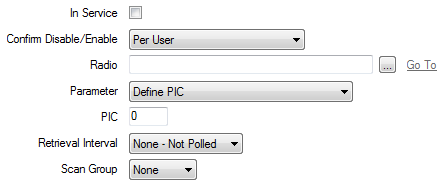Configure the Common Point Properties
Use these fields on each Advanced Trio Diagnostics Point Form’s <Point Type> tab to configure these driver-specific point properties:

Use to specify whether the point is active or inactive (see Placing an Item In Service).
Users with the required permissions can disable a point that is In Service, or enable a point that is not In Service. Such actions are carried out using the Disable Point and Enable Point pick actions.
Use the Confirm Disable/Enable combo box to specify whether a confirmation dialog box is displayed whenever an operator requests that this point is disabled or enabled (see Requesting Confirmation of Action Requests).
Use to specify the database item that represents the Trio radio from which Geo SCADA Expert is to retrieve diagnostics data, or control a relay output or hot-standby changeover, using this point.
Select the browse button to display a Reference browse window, then select the required radio from the window.
With a hot-standby radio setup, two radio units function as one base radio (with only one of the radio units being active at a time). With such a setup on E Series and Q Series Trio radios, you use two Advanced Trio Diagnostics Radio database items to represent the base radio, and two sets of points to represent each item of diagnostics data, or each output that Geo SCADA Expert is to control in the base radio. You associate one set of points with each Radio in the database (see Retrieve Data from a Hot-Standby Radio). With a D Series hot-standby radio, you only require 1 Radio and 1 set of points in the database (as Geo SCADA Expert does not poll the offline radio unit.)
Use to specify the Parameter Identifier Code (PIC). The PIC identifies the diagnostics parameter that Geo SCADA Expert's Trio Diagnostics driver is to read from the radio for this particular point, or the output that the point is to control.
Use the Parameter field’s arrow button to display a list of PICs. The options vary depending on the type of point and the type and series of radio with which the point is associated. You should select a PIC that exists on the Trio radio from which Geo SCADA Expert is to read diagnostics data, or control the outputs. D Series radios support a limited number of PICs compared to other supported series of radios. For more information about the PICs that are supported, see the documentation supplied with your Trio radio equipment.
If the PIC that you require is not listed, but can be retrieved using the selected point type, select the Define PIC option. Further field(s) become available on the Trio Diagnostics tab to enable you to specify the PIC details.
Only applies when the Parameter field is set to ‘Define PIC’. Specify the Parameter Identifier Code (PIC) of the PIC that Geo SCADA Expert's Trio Diagnostics driver is to read from the radio.
Use this combo box to determine how often the server polls the radio to retrieve the point's diagnostics data.
The server only polls the radio for the point's data when:
- The server, driver, channel, radio set, radio, or point has become active (In Service) after previously being inactive (not In Service). For example, when the point is placed In Service following its creation in the database.
- The radio on which the point is located and/or to which Geo SCADA Expert is connected has been out of communications with the server and communications are restored.
- The Refresh pick action is triggered on the radio.
You might want to select this option, for example, if the point is being used to retrieve an item of diagnostics data that the radio will transmit automatically to Geo SCADA Expert. Only some series of Trio radio support auto-diagnostics.
The server polls the radio for the point's data at timed intervals. The actual frequency of the selected interval is configured on the corresponding Advanced Trio Diagnostics Radio Form (see Define the Data Polling Intervals). With points on D Series radios, only Interval 1 is available.
The Retrieval Interval defines the polling frequency between Geo SCADA Expert and the radio on which the point is located. If Persistence is used, any point state changes will be delayed until the specified persistence time has expired. If the point is configured to use Significant Change, any change in point value will only be recorded if the change exceeds the Significant Change deadband.
Use the combo box to specify the Scan Group with which the point is associated. The Scan Group determines the minimum frequency with which the driver updates the server with the current value for the point. This provides confidence that all is well between Geo SCADA Expert and the Trio radio, as the point is updated in the database at the Scan Group rate, regardless of whether the point has changed in the radio.
The specified Scan Group triggers a poll for data at the corresponding Scan Group interval. You therefore typically assign a Scan Group that has an interval that is a multiple of the point’s Retrieval Interval rate. Be aware that if a Scan Group is specified that has a faster interval than the Retrieval Interval, polling will occur at the Scan Group rate (however, this is not recommended).
You specify the frequency of each Scan Group on the Scan Parameters tab of the associated Channel Form (see Define Intervals for Timed Current Data Updates).
Further properties are included on the <Point Type> tab for some types of point. For information on those properties see, as appropriate: